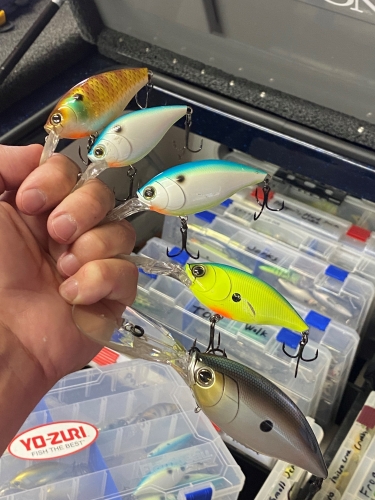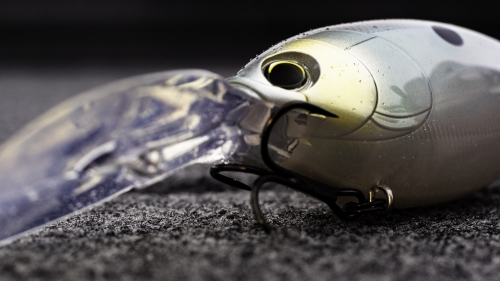BLOG
Late Fall Crappies
 Late fall crappies can be elusive as they move around, hunting and feeding available forage.
Late fall crappies can be elusive as they move around, hunting and feeding available forage.
Aggregations of fish make a move to the deeper water basins in local lakes, but before this
migration happens, there's a lot of commotion going on in remaining weed growth as slab
crappie strap on the proverbial feedbag.
__large.jpg)
When fish are holed up in a general area, the most common presentation involves floats and
jigs. This is the perfect presentation for capitalizing on a group of fish. This scenario can result
in the most epic of fish-catching bonanzas.
There are times though, when you will find crappies cycling through shallow weed flats,
sometimes in 2-4 feet of water. These fish can be spotted visually when winds are calm, while
slowly moving the boat through sparse remaining weed beds. Once you see fish, it's a real sign
that it's time to strain some water and latch on to these fish up shallow. Start the fan-casting
program to connect with active fish.
Float fishing can get the job done in this situation, however, can be very inefficient as fish are
constantly on the move chasing down bait. In this instance, consider using a small suspending
jerkbait to cover water faster and convert crappies on patrol into hook up's.
Case in Point
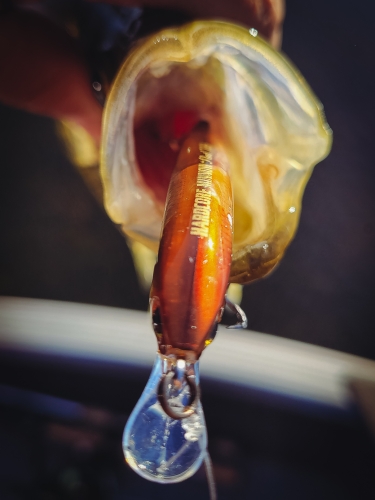
On a recent late fall trip we had the perfect calm conditions and water temps in the low 40's.
Protracted warm weather days seemed to keep the shallows active with bait and predators.
We could spot fish using polarized glasses, and even witnessed some surface activity with
schools of minnows being busted. I used the Hardcore Minnow Flat SP 70mm to make long
casts and cover water. The mini-jerkbait fishes perfectly with the rod tip up, diving no deeper
than 11-18" of water.
There are two key attributes of this bait that brought this presentation together. First the
Hardcore Minnow Flat SP utilizes a magnetic weight transfer system allowing a ridiculously long
cast with a small, light bait using 10lb Yo-Zuri Superbraid.
The second part of the deal was the perfect suspending nature of this jerkbait. Strikes tended
to happen as soon as the bait hit the water and rested, or as the bait stalled on the jerk-jerk-
pause presentation. Tightening the line to move the bait forward often resulted in an instant
hook up as the crappies just crushed it.
When employing this approach, remember that cold water demands a lighter touch, with short
movements of the rod tip to impart movement. At this time of the year, it’s generally
preferable to leave the consistent faster approach for warmer seasons.
Before I forget, a great tip to help prevent bite offs from the inevitable bonus northern pike,
involves tying in a six-to-eight-inch section of 20lb T7 Premium Fluorocarbon as a bite-resistant
leader. Don’t worry, the diameter and weight of the leader doesn't significantly impact the
action of the bait.
Throwing small jerkbaits like the Hardcore Minnow Flat SP 70mm is an absolute blast and can
lead to some of the most consistent late fall crappie action!
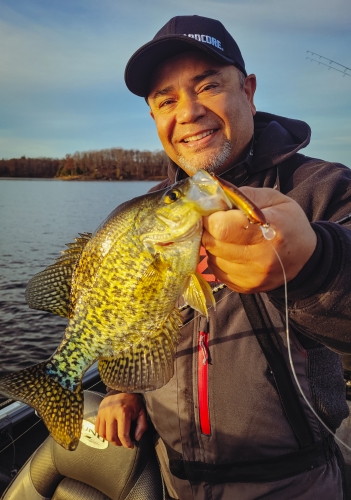
Will Nalley
‘Tis the Season for Lipless Crankbaits
 With so many lures available to anglers today, it can sometimes be a challenge to best determine what lures we should use when pursuing our favorite species through the ice. Lipless crankbaits, a renown fish-catching lure type throughout the open water season, work incredibly well throughout the hardwater months in the Ice Belt. Yo-Zuri offers several sizes and patterns of lipless crankbaits that ice anglers can count on when chasing everything from panfish to predators.
With so many lures available to anglers today, it can sometimes be a challenge to best determine what lures we should use when pursuing our favorite species through the ice. Lipless crankbaits, a renown fish-catching lure type throughout the open water season, work incredibly well throughout the hardwater months in the Ice Belt. Yo-Zuri offers several sizes and patterns of lipless crankbaits that ice anglers can count on when chasing everything from panfish to predators.
Early Ice
Early ice starts right after there is enough ice to walk on lakes and lasts until about the third or fourth week of January. It is the time of the ice season where big, noisy baits work really well for walleyes and northern pike alike. The Yo-Zuri 3DR-X Vibe is a 2 3/8” deep-bodied lipless crankbait that rattles as it is ripped through the water column. The patented scale pattern adds an extra dimension of realism to its presentation so that even less aggressive fish might be tempted to strike. Going with ten pound test Dark Green SuperBraid, ten pound test Hybrid, or ten pound test T7 Fluorocarbon is recommended to avoid bite-offs as fish often take the entire lure in their mouths when they hit.
__large.jpg)
Early Ice Scenario
One of the best situations in which a larger lipless crankbait like the 3DR-X Vibe works well on early ice is in 8-10’ water with a sand/rock bottom adjacent to deep water. Finding areas with sparse weed patches can be even better as they may attract and even hold fish in some cases. Dropping the 3DR-X to the bottom and pounding it several times followed by quick 1-2’ rips upward can be a great way to draw fish in from afar. Once fish approach, it may be necessary to dial back the rips to a more subtle jigging movement interspersed with a quick, short twitch. The twitch with the 3DR-X Vibe is intended to simulate a wounded minnow and will often provoke a strike.
Mid-Winter
Once the ice thickens to 20” or more the bite windows can become much narrower each day, oftentimes requiring that fishing efforts be refined to dawn and dusk to maximize fish-catching potential. With the increased snow and ice that comes with mid-winter, it is often necessary to refine lure sizes and the cadence at which they are worked to get more finicky fish to bite. A 2 1/8” lipless crankbait like the Yo-Zuri Rattl’N Vibe can be a great solution to mid-winter blues as it is a shorter and thinner profile lure that mimics minnows upon which the fish are feeding. Six pound test T7 Fluorocarbon or six pound test Hybrid lines offer the strength needed to land bigger fish while still allowing a more finesse-based presentation that is important to get finicky predators to bite.

Mid-Winter Scenario
A classic mid-winter scenario occurs on underwater humps. An area that comes up to 10’ of water but is surrounded by 20’+ of water is an area in which walleyes and northern pike cruise for unsuspecting prey during lowlight periods in mid-winter. Dropping the Rattl’N Vibe to bottom, letting it sit on the bottom of the structure for a few seconds, and then gently lifting it up to about 1’ off the bottom can be a great way to entice fish to bite. The subtler lift and fall presentation coupled with light jigging strokes when fish approach the Vibe uses the built-in rattle system to initiate clicks the fish can hear and then react with strikes. Luminescent patterns are especially productive this time of year because of their glow characteristic, making lures more easily seen when visibility is low.
Late Ice
Late ice is the time during the ice season when snow has begun to melt or has melted off the ice and back into the lake. This is a prime time to pursue large panfish using miniature lipless crankbaits. The Rattl’N Vibe Mini is a 1 5/8” miniature crank that big crappies cannot resist during late ice. If the lake being fished is commonly known for bass, northerns, or walleyes, then going with four pound Hybrid Ice is recommended. If the system being fished has predators, but they are not as pronounced, then the Mini works great with three pound Hybrid Ice line.
__large.jpg)
Late Ice Scenario
A classic late ice scenario for big crappies includes a combination of using the basin of the lake and shoreline structure. During midday using metallic, UV, or luminescent Rattl’N Vibe Minis over basin areas are solid considerations for initiating uphits. For example, if fish are located 15’ down in 25’ of water, then jigging a Black Silver Rattl’N Vibe Mini around 13-14’ just above the school is recommended. As the day progresses into the last hour of daylight, changing positions to old weedlines can be a fruitful approach. Even if the weeds are dead, they may be the only cover available, and big crappies will often congregate in and around them as the sun gets closer to setting. The same lure and patterns can be used in this area, but jigging rapidly in, around, and just outside of the weeds within 2-3’ of the bottom can be highly productive to lure big slabs out of hiding.
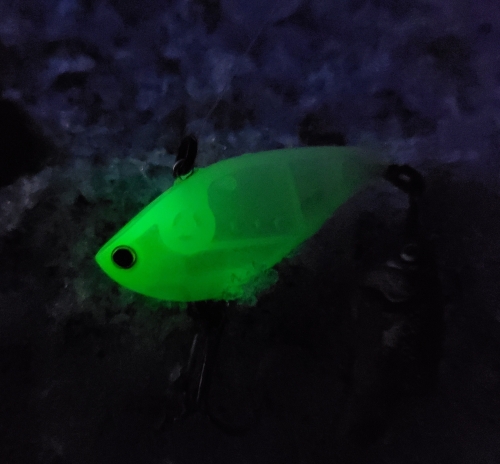
Whether you are in pursuit of predators or panfish, lipless crankbaits can be a highly effective lure style to use throughout the entirety of the ice season. Adding lipless cranks like the Yo-Zuri 3DR-X Vibe, Rattl’N Vibe, and Rattl’N Vibe Mini to your arsenal will increase your chance of catching some great fish on hardwater. Visit yo-zuri.com today to learn more about the different Vibes mentioned in this article.
Tight lines and have a safe ice season!
Fall Success is just One Knock Away
 Early fall can be a very challenging time to find fish. Each year I learn a little more about finding fish through a little trial and error. This year has been no exception.
Early fall can be a very challenging time to find fish. Each year I learn a little more about finding fish through a little trial and error. This year has been no exception.
The local lake I was fishing can produce decent numbers of bass and pike. I had fished it a number of times before in summer so I wasn't going in totally blind.
With water temps in the mid to upper 50's I figured fish would be found relating to a weed edge with an adjacent so drop as the gusty winds were pushing up against the edge. My searches were not fruitful, yielding only a couple of small fish.
When I'm not putting together any repeatable pattern, I turn to covering as much water as I can. Since the deeper edges didn't yield the results I was hoping for, I pushed up on the shallow flats ranging from 3-8 feet of water. My primary choice for covering water on the this trip is the Yo-Zuri Rattl'n One Knock. This lure is slick, rattles, and flashes perfectly for the job I was doing – lots of great colours to choose from too. It's the perfect lure for burning on a straight retrieve, ticking the tops of weeds to trigger strikes.
A key part of this presentation is that these baits falls straight when I stop reeling, without turning over on itself. On the pause, if the bait gets hung up on some weeds, a quick snap breaks the weeds off, clearing the hooks – the act of snapping the weeds off the hook is often what generates the strike. Other times the fish were instantly alerted and smashed the bait right away when it hit the water. This was the case for both bass and pike.
My choice of combo for this presentation is a medium heavy casting rod, high speed retrieve baitcaster spooled up with 40lb Yo-Zuri Super Braid. In order to avoid losing baits to the inevitable toothy gator, I make my own heavy Yo-Zuri 50lb HD Flourocarbon leaders. I tie braid direct to the leader. These homemade leaders can save the day on our local waters where northern pike abound.
In short, fall fishing can be some of the most challenging, and the most rewarding times of the year. Success is only One Knock away.
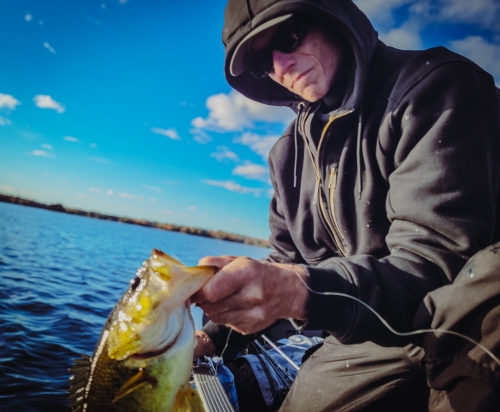
Will Nalley
Multi-Species Fishing Trips: A Late Summer Hard Bait Approach
Many fish species can be found throughout the water column during the late summer period. Panfish and predator species alike can be caught at or near the surface of the water column, hunkered down in thick vegetation or cruising weedlines adjacent to steep drops, or suspended over deep basins during this time of year. Having a variety of hardbaits that cover each level of the water column during late summer can improve the odds of catching several fish species in one fishing trip.
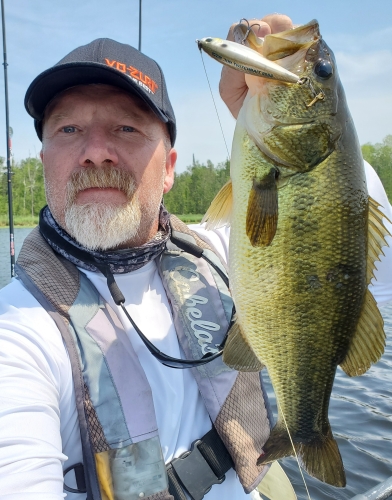
Surface
With so much bug life and baitfish congregating at or near the surface of the water column, late summer can be a great time of year to chase largemouth and smallmouth bass and northern pike using poppers. The Yo-Zuri 3DR-X Popper is a smaller profile lure at 2 5/8” and 1/4 oz. that works well during lowlight periods of the day, when the wind is under 5 miles per hour, and when fish are extremely finicky. The Bone or Ghost Prism Frog are solid patterns when fished within open pockets formed by lily pads and when chasing fish hunkered down in weeds during the heat of the day. Yo-Zuri 20 lb test SuperBraid is a top line choice when using the 3DR-X Poppers in and around weeds as it is strong enough to hold large bass or pike when they dive for thick cover as is often the case after a strike.
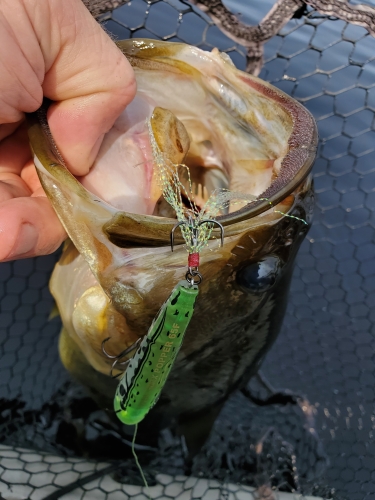
Mid-Depth
While many walleyes will shift their focus to deep humps, rock piles, and deep flats during late summer, there are inevitably going to be fish that frequent structure in less than 12’ of water as well. Larger walleyes will hunt in and around large cabbage patches where small perch, bluegills, and other minnows seek cover. At 4 3/8” and 1/2 oz., the 3DB Jerkbait 110 Deep is a hardbait that stands out among smaller forage that gets the attention of large walleyes waiting for an easy meal to pass in front of them. The Bold Table Rock Shad is arguably one of the most versatile patterns when fishing for walleyes in weeds as it can be effectively fished in clear or tannic-stained water. Changing up the cadence used from fast twitches to simply pulling the Jerkbait forward a few inches at a time allows the Yo-Zuri “Wave Motion Technology” to maximize vibrations that walleyes cannot resist.
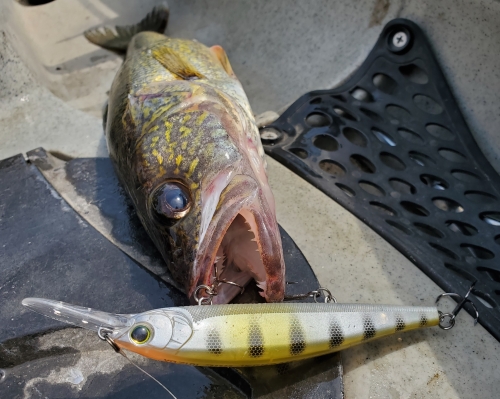
Deepwater
Although bluegills and crappies can be found in weeds and wood in late summer, this can also be a great time of year to pursue large schools of fish that suspend over deep water chasing smaller minnows and invertebrates. It is common to find marauding packs of panfish suspended 15-20’ down in 35’+ of water during this time of year. The Rattl’N Vibe, at 2 1/8” and 3/8 oz., is a large enough profile lure that sinks to suspended panfish quickly to maximize water covered effectively, but it is still small enough that big panfish will regularly eat it. Tying Yo-Zuri 6 lb test Hybrid line to the Vibe and then jigging, drifting, and trolling are all great options when pursuing suspended panfish. The Luminescent is a glow-based pattern that works regardless of water clarity and is an excellent choice early and late in the day when light is diminished.
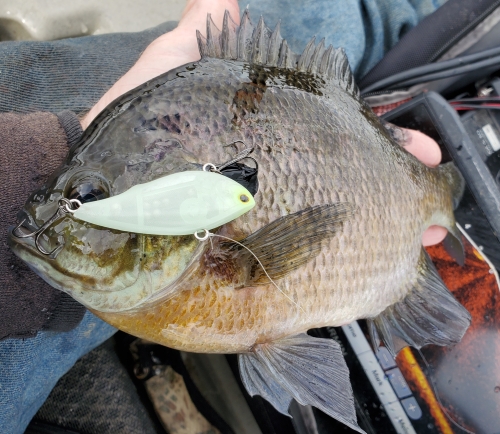
The late summer period can be a great time to chase multiple species of fish in the same trip. Coupling Yo-Zuri lines with the 3DR-X Popper, 3DB Jerkbait 110 Deep, and Rattl’N Vibe can give you the opportunity to maximize results during your next multi-species trip on the water.
Tight lines and be safe!
- Mark Maule
Icing Midwinter Predators with a Variety of Vibes
 Midwinter regularly means a lot of snow, thick ice, frigid windchills, and fish that can be more challenging to catch. Although they can be lethargic due to the harsh conditions at this time of year, walleyes, northern pike, and bass can still be consistently caught with hardbaits. The Yo-Zuri 3DR-X Vibe, 2 1/8” Vibe, and Rattl’N Vibe Mini are all great options to chase predators throughout the midwinter period.
Midwinter regularly means a lot of snow, thick ice, frigid windchills, and fish that can be more challenging to catch. Although they can be lethargic due to the harsh conditions at this time of year, walleyes, northern pike, and bass can still be consistently caught with hardbaits. The Yo-Zuri 3DR-X Vibe, 2 1/8” Vibe, and Rattl’N Vibe Mini are all great options to chase predators throughout the midwinter period.
3DR-X Vibe
__large.jpg)
At 2 3/8” and 1/2 oz., the 3DR-X Vibe is a new lipless deep-bodied crank with rattles that can be highly effective in the transition from early ice to the beginning of midwinter. The 3DR-X Vibe is large enough to get the attention of predators from a distance but still small enough that they will strike upon approaching it.
One of my favorite uses of this Vibe is lowlight conditions at dawn and dusk. When predators push up into the 8-12’ depths of the water column early and late in the day, they are looking to feed. These prime times are a great opportunity to use the 3DR-X Vibe to capitalize on the aggressiveness of these fish. Jigging in 1-2’ intervals, dropping the lure to the bottom and bouncing it several times followed by a 1-2’ lift, and then slowing down to more of a rocking motion once a fish approaches works great for simulating injured or dying baitfish. Going with 6 lb test Hybrid Ice is a solid line choice that offers strength, thin line diameter, abrasion resistance, and maximum action capability.
2 1/8” Rattl’N Vibe
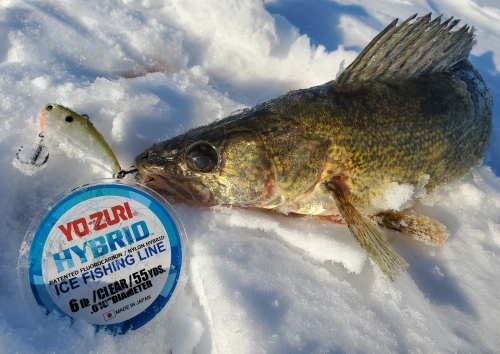
The 2 1/8” Rattl’N Vibe is a 3/8 oz. lipless crankbait that offers anglers an opportunity to effectively downsize from a bigger options that might draw fish in but does get them to commit. Its thin profile, rattle, and balance make this Vibe a solid choice as the midwinter period progresses.
Jigging the 2 1/8” Vibe on sharp breaks in 14-20’ of water and 12-14’ underwater humps adjacent to 18-20’ of water works great for walleyes, northern pike, and bass in midwinter. I like to work this lure several feet off the bottom with 2-4’ rips of the rod tip to make a lot of noise. Lifting the lure fast, then pause completely as it sinks back to the original depth, and then pause for a few seconds is a good cadence to use as the fish will hit the lure at any time during the movement. This can be highly productive for northern pike specifically as they often cruise higher in the water column in midwinter than other predators. When fishing walleyes and bass in the same locations with the 2 1/8” Vibe, I like to drop it all the way to the bottom and stir up the substrate with bouncing movements to mimic young minnows feeding on invertebrates and worms. The cadence for this approach includes several bounces to the bottom, lifting the lure up to 1’ off of the bottom, and then pausing. When walleyes and bass approach, lift upward slowly with fluid movements to elicit strikes. Because this lure will be used to chase predators of all sizes, I again go with 6 lb test Yo-Zuri Hybrid Ice line.
Rattl’N Vibe Mini
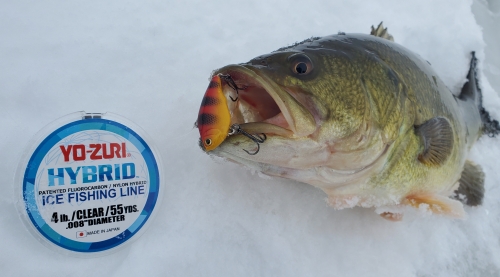
At 1 5/8” and 3/16 oz., the Rattl’N Vibe Mini is arguably the most versatile hardbait available as it ices everything from perch to northern pike well over three feet in length. It is a lipless crankbait that is a smaller version of the other Vibes, which is important when fish show interest in the bigger version but do not bite them. Sometimes downsizing to the Rattl’N Vibe Mini can turn finicky fish that swim by the 3DR-X Vibe or 2 1/8” Vibe into fish that eat.
The Mini can be fished effectively at any time of the day and at any depth in the water column. With 15 available patterns, these small Vibes can be used to match whatever forage upon which the fish are feeding. Natural patterns like the Hot and Green Perch work well in clear water less than 12’ deep. The Luminescent, UV, and metallic patterns are solid options to go with in stained water, where light penetration is significantly decreased due to heavy snow and ice cover, and in deep water. Generally speaking, the cadence with the Rattl’N Vibe Mini is going to be a lift of 1-2’, pause and drop, and then lift again. As a fish approaches, a slight movement of the lure coupled with a lift is recommended. This is a small lure and the fish still need to see it, so lifting too aggressively might take the offering out of their view or make them disinterested if they are lethargic. When pursuing predators with the Mini, I recommend going with 4 lb test Yo-Zuri Hybrid Ice line as it will offer the line strength needed to land bass, walleyes, and northern pike while still giving you the best action possible with such a small lure.
Midwinter can pose a host of obstacles to anglers chasing predators below the ice, but this is no time to give up on using hardbaits. Now is the time to turn to a variety of Vibes like the Yo-Zuri 3DR-X Vibe, 2 1/8” Rattl’N Vibe, and Rattl’N Vibe Mini to catch more fish!
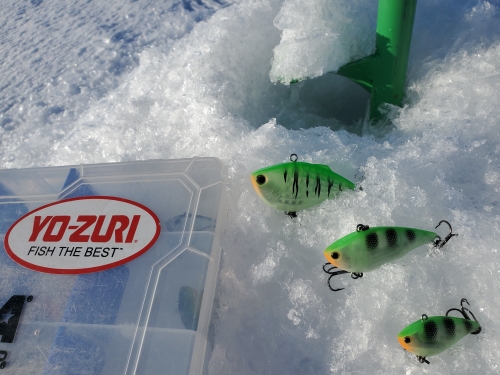
Crank Your Way To Suspended Late Summer Slabs
 Crank Your Way To Suspended Late Summer Slabs
Crank Your Way To Suspended Late Summer Slabs
Mark Maule
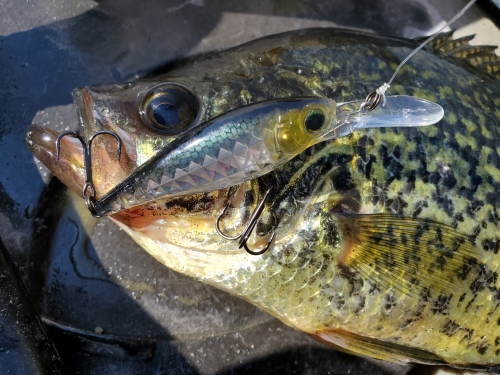
Bobbers, worms, tiny jigs and hooks, and flies are oftentimes associated with chasing
large panfish. However, summer is the time when big panfish, especially nomadic suspended
slab crappies, become hungry predators. The late summer period can be an especially effective
time to capitalize on their voracious appetites by using small crankbaits for fish suspending just
below the surface down to the thermocline.
3DR-X Shad
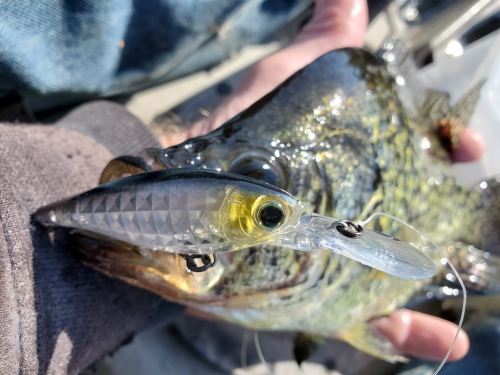
When big crappies are suspended within the first 5’ of the water column, the 3DR-X
Shad is a must. The 3DR-X Shad is a new 2 3/8”, 1/4 oz. suspending crankbait that can be
worked just under the surface of the water down to about 5’. It is an exceptionally versatile
small crankbait with an internal scale finish that perfectly mimics the minnows that crappies
feed on near the surface. It can be casted, trolled, or drifted effectively for shallow suspended
fish. Casting when conditions are calm, especially at dawn or dusk, can be a dynamite way to
fish the 3DR-X Shad when a more finesse-based approach is needed. When windier conditions
exist, trolling and drifting the 3DR-X Shad can be great ways to cover as much water as possible
to chase bigger crappies feeding near the surface.
3DB Shad
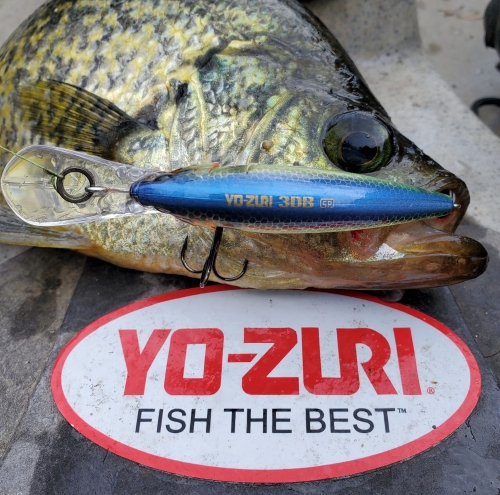
Depending on the conditions and where the forage is located, crappies will sometimes
be found a bit deeper as summer progresses. In these instances, it may be necessary to dig
down a little further in the water column to catch them when they are suspended. The 3DB
Shad is a 2 3/4” and 3/8 oz. lure that works well when chasing crappies that suspend 8-12’
down in the water column. This lure will dive to around 6’, which works great for mid-range
crappies as these fish are notorious for uphitting a lure. Fish over 12” will readily come up 4-6’
in the water column to chase down a larger meal during the late summer period. Trolling is
arguably one of the most effective ways to fish the 3DB Shad for big crappies in late summer. It
is a search bait that allows for covering a lot of water, and it elicits strikes from the most
aggressive bigger fish in a school when trolled quickly above them.
2 1/8” Rattl’N Vibe
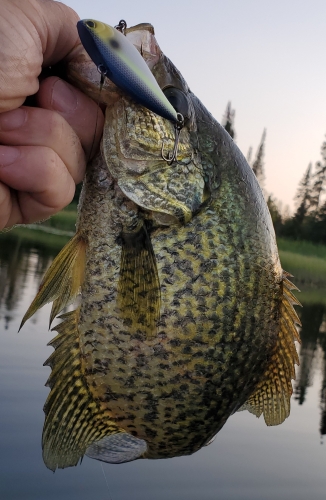
The 2 1/8” Rattl’N Vibe is a 3/8 oz. lipless crank that works great for situations where
crappies are suspended from 12’ down to the thermocline. This lure is large enough to sink to
the depths where the fish are located, yet, it is small enough so that larger crappies will still
readily feed on it without hesitation. Experimenting with the movement of the 2 1/8” Rattl’N
Vibe is key feature when fish are stationed more than 12’ down as it is possible to catch big
crappies by casting, trolling, drifting, and jigging. The key is to make sure that the lure is
constantly moving to resemble a struggling baitfish so fish instinctively attack it.
As the heat of summer progresses, choosing crankbaits that cover all areas of the water
column where fish are located can put some solid crappies in your livewell. Gear up with the
3DR-X Shad, 3DB Shad, or 2 1/8” Rattl’N Vibe, and get ready for some late summer slab action!
Stay safe and tight lines!
Watch as Mark Maule shows the guys from Midwest Outdoors how he uses the Rattlin' Vibe Mini on his Kayak for crappie and panfish:
<iframe width="560" height="315" src="; title="YouTube video player" frameborder="0" allow="accelerometer; autoplay; clipboard-write; encrypted-media; gyroscope; picture-in-picture" allowfullscreen></iframe>
Topwater Transitions for Bass from Spring to Fall
 The changing of the seasons oftentimes makes it is necessary to modify fishing approaches in order improve fish catching opportunities. Like with any other lure type, changing up topwater presentations from spring through fall can lead to catching more bass as they shift their focus toward different types of prey and forage eaten with each of these seasons. Yo-Zuri hardbaits are a great option to consider for these necessary seasonal changes as they offer a host of different topwater lures and patterns to fit whatever situation with which the fish present us.
The changing of the seasons oftentimes makes it is necessary to modify fishing approaches in order improve fish catching opportunities. Like with any other lure type, changing up topwater presentations from spring through fall can lead to catching more bass as they shift their focus toward different types of prey and forage eaten with each of these seasons. Yo-Zuri hardbaits are a great option to consider for these necessary seasonal changes as they offer a host of different topwater lures and patterns to fit whatever situation with which the fish present us.
Spring
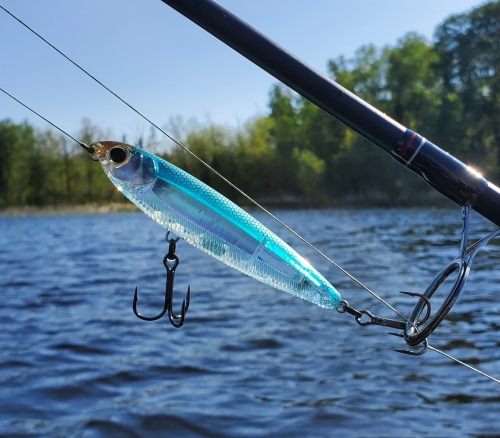
The Yo-Zuri 3DB Pencil is one of my favorite springtime lures as the fish are getting aggressive and ready to feed heavily after being hunkered down by several months of winter. These Pencils are big enough to get a fish’s attention as they prepare for the upcoming spawn, and they can be worked slow enough in the case that some fish might be more lethargic during cold front conditions. If the water and/or air temperature is lower than 50 degrees, I like going with a straight twitch and pause retrieve while using a 4” Pencil. Moving the lure 1-2’ at a time slowly forward and then pausing for up to 10 seconds can be highly effective. The pause is the key because that is when many fish will either strike or position themselves right under the lure to strike it when it starts moving again. After air and water temperatures supersede 50 degrees, then it is time to go with the classic “walk-the-dog” style retrieve where the lure moves from side to side while using a 5” Pencil. Warmer surface temperatures in spring can mean more and bigger minnows swimming in schools near the surface or in shallower bays, and when that happens, the aggressive nature of the side-to-side movement can elicit strikes because of predators already looking up and feeding on bigger active minnows.
Summer
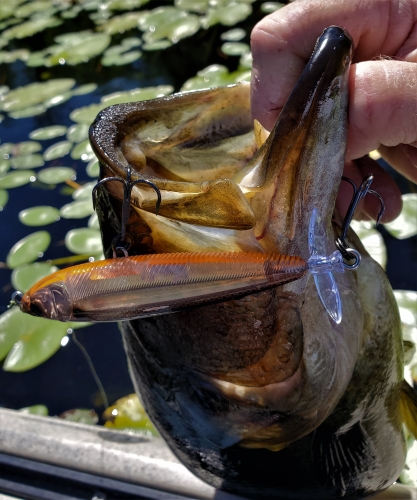
Once surface temperatures exceed the low 60s, we often see a significant increase in the amount of active bug life on the water. One specific insect that I look for during the summer months is dragonflies. When I see dragonflies, I switch from the Pencil to the Yo-Zuri 3DB Prop. The key to the Prop is that it has a plastic propeller which simulates the sound that a dragonfly makes when it is flapping its wings on top of the water. This lure can be used effectively from sunup to sundown, even when it is extremely sunny and calm, because of the presence of dragonflies. A general retrieve that I like to use is to cast the 3DB Prop parallel to emergent weeds that are adjacent to submergent vegetation and use a start-and-stop retrieve. I like to cast the lure, let it sit for 5-10 seconds so that fish can begin keying in on its silhouette right from the start of the cast, and then I go with anywhere from 1-4 cranks of the reel handle. The goal is to get the plastic prop to sound like a dragonfly’s wings flapping on the water, so sometimes reeling slower is necessary to make sure they can target the lure and eat it. Waiting to feel the fish’s weight during the strike will be paramount to improve the number of fish being hooked because simply going by sight might lead to pulling the lure away from the fish.
Fall
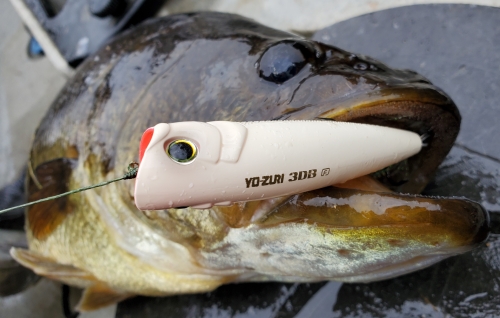
Fall is one of my favorite times of year to use topwaters as bass are hungry and feeding heavily in preparation for the upcoming long winter months ahead. The key to fall strategies for topwater lures is that I go by the first hard frost of the year versus when the calendar indicates the beginning of this season. Sometimes this happens in late August and sometimes it occurs in the at the end of September. My favorite way to pursue bass in the fall is with a Yo-Zuri 3DB Popper. I have found that using heavier line, like a 50 or even 65 lb braid, can be useful when tied directly to Poppers this time of year because I like to cast them right into any remaining emergent weed cover (even if it is dead due to frost) and retrieve it out over submergent weeds. Poppers work great in late fall as they offer a larger profile meal with little energy expenditure needed to chase them down. The Popper retrieve in fall is all about slowing things down and being patient. A cast usually entails letting the lure sit for up to 20 seconds or more after hitting the water, twitching the lure slowly 1-4 times so that it gurgles instead of splashes, and then pausing up to 20 seconds again. Using Poppers in late fall is often a case of the adage, “less is more,” when it comes to movement and noise on top of the water.
Being versatile with topwater hardbaits and adjusting the lure used based on the season can reap significant improvements in the numbers of fish that are landed. If you are looking for some exciting explosive bass action during the transitions from spring through fall, then casting an assortment of Yo-Zuri Pencils, Props, and Poppers is well worth your effort!
Mark Maule
Fall In the Ice Belt: The Season When Panfish Become Predators
When leaves are changing colors and temperatures start to drop in the Northwoods of the Ice Belt, we transition into that special time of the year when big crappies and bluegills start feeding heavily on minnows in preparation for the looming winter ahead. In fall when water temps drop below the 55-degree mark specifically, the Yo-Zuri Rattl’N Vibe Mini becomes a staple hardbait that any panfish angler should consider as part of their arsenal.
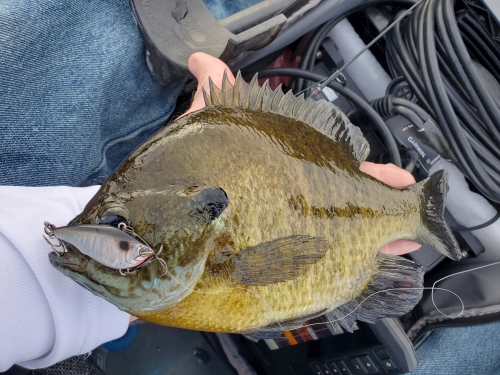
Lure: At 1 5/8” and 3/16 oz, the Rattl’N Vibe Mini is a micro lipless hardbait which is a little bit bigger than a crappie minnow, but a little bit smaller than a fathead minnow. The Mini is arguably the most versatile hardbait available in today’s fishing market as it can be fished in any type of water; it can be jigged, drifted, trolled, or casted; and it brings in some incredible northern pike, walleyes, and even bass while chasing large panfish.
Line: Yo-Zuri 4 lb test Hybrid on an ultra-light rod and reel set up is a great choice for chasing big crappies and bluegills in fall. Another option to consider is to break out the ice rod and reel combos spooled up with Yo-Zuri 4 lb test Ice Hybrid or 4 lb test Ice Super Fluorocarbon as much of the fall is a precursor and foreshadowing to where large schools of the biggest panfish will be lurking once the ice forms. Using the ice rod and reel combos during the fall period is a great way to get practiced up in advance of the upcoming ice season.
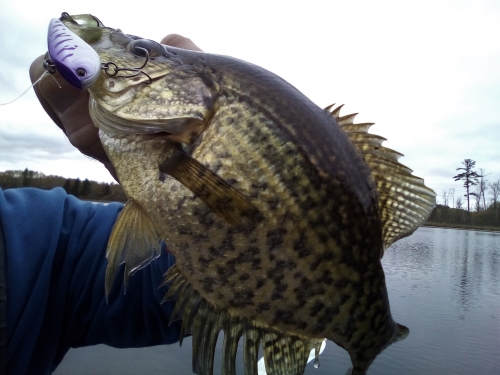
Location: Suspended crappies and bluegills are prime targets for using the Rattl’N Vibe Minis as some of the largest fish of these species can be found roaming basins or basin edges. It is relatively common to find schools of panfish chasing minnows 15’ down in 25’ or more of water before and after the fall turnover. Hot Perch and Green Perch are great patterns for chasing suspended fish in clear water as they have are more natural patterns and can be preferred when large panfish are keying in on specific prey like baby perch in the middle of the water column in the middle of the day. If fishing in tannic-stained water or waters impacted by the mixing of oxygen throughout the water column during turnover, then the glow patterns (Luminescent or Luminescent Perch); UV patterns (UV Purple Tiger, UV Blue Tiger, and UV Pink Tiger); or metallic patterns (Black Silver or Gold Black) come into play. These glowing- and flashing-based patterns are meant for eliciting reaction strikes when water clarity is obscured.
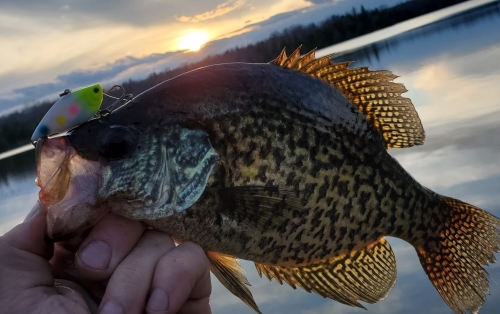
Fishing the Mini: Two solid ways to fish the Rattl’N Vibe Mini include working the lures above and in front of schools of marauding panfish. Slow trolling or drifting and lifting 1-2’ above located schools of crappies and bluegills works great for suspended fish as the largest of each species will often come up several feet to up hit the lure. Jigging and even casting the Rattl’N Vibe Mini 8-10’ in front of moving fish can be another solid option to consider when working the lures because the voracious feeding instincts of the largest panfish will propel them ahead of smaller fish to pick off easy meals.
When panfish turn predators in fall, it is time to stock your gear boxes with the Yo-Zuri Rattl’N Vibe Mini as you might just catch the biggest panfish of your open water season!
Tight lines and safe fishing!
– Mark Maule
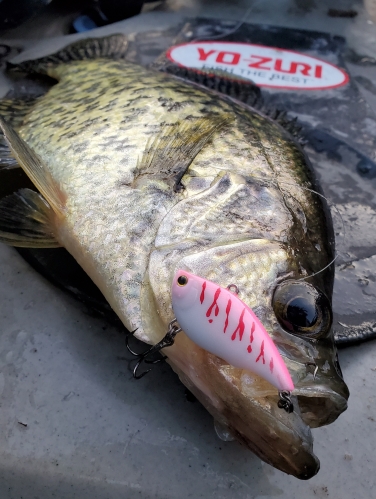
Fall Snook Fishing
The start of the fall season in South Florida doesn’t come with falling leaves or dropping temperatures like the rest of the country. Instead, its marked by the start of Snook season. You can always tell when Snook season starts by the zombie like appearance of guys/gals on their third trip back from the coffee maker at work. Success can certainly be had during the day but for a large percentage of anglers Snook fishing is a night or pre-dawn game. Snook are very active at night throughout all phases of the moon and can be targeted with a variety of techniques. This write-up focuses on hard bait techniques for night fishing, particularly around structure like bridges and jetties.
The fall snook season, particularly on the east coast of Florida, can be broken down into three phases: pre-mullet run, mullet run and post mullet run. Each phase offers its own unique challenges and opportunities.
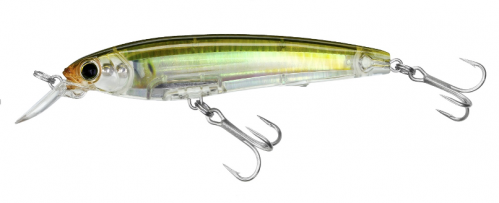
The pre-mullet phase typically features very hot and humid nights, with a limited amount of wind and the fish are often keyed in on small bait like sardines, pilchards and glass minnows. There is always resident mullet but not the giant schools you see during the mullet run. The challenge for this time of year is getting fish to bite that are keyed in on smaller profile bait, often in still and clear water conditions. One of my favorite baits for this time of year is the Yo-Zuri 3D Inshore Fingerling in the 4 inch (100mm) size. This bait was introduced at ICAST 2021 but was modeled with the exact same action and body design of the 3DS Minnow 100. The 3DS Minnow is a bait that has caught hundreds of thousands of Snook and been a favorite of fisherman for 10+ years. The issue was the hooks and split rings were designed for freshwater and needed to be switched out. The new 3D Inshore Fingerling comes with full saltwater terminal tackle that can handle most fishing conditions and Snook into the 40+ inch range. The Fingerling is especially effective at this time of year for a couple reasons. One its at the top end but not outside, the typical bait size for this part of the season. It has a shape similar to a sardine, and is close enough to the size of a small pilchard or glass minnow. It has a very tight swimming action that mirrors the swimming pattern of these prey species. The third and most unique feature of this bait is the diamond shaped lip. For land-based anglers like me this is extremely important. The first thing you notice with this bait is it stays in the water all the way back to your rod tip even when fishing from an elevated position.
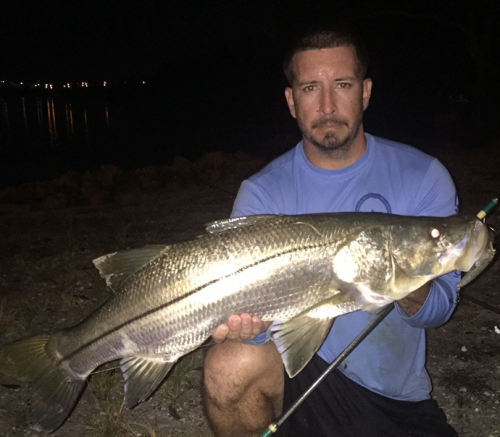
One of my favorite places to fish this bait is at the bridges along the shadow lines where snook wait to ambush prey. Get on the up current side of the bridge and cast out into the light away from the bridge at roughly a 45-degree angle. Slowly retrieve the plug and let it swing into the shadow line with the current. The key is to get the bait to come into the Snook face right on or just outside (within 6 inches) of the shadow line. The angle of your cast will need to be adjusted based on the where in the phase of the tide you are/the speed of the current. For most of the tide a 45 degree cast is best but near the slack phase you can cast 6 to 12 inches outside the shadow line and work it down the edge of the line. Because the 3D Inshore Fingerling stays in the water longer than other lipped minnow baits, it allows you to cover more of the shadow line on each cast and I have caught fish that were sitting within a couple feet of where I am standing. Another great location for fishing this bait is along the rocks at the jetties. Early season Snook tend to be very close to the rocks at the jetty. Unlike other baits that come up and out of the water close to the jetty the Fingerling stays in the water all the way up to the rocks and many of the bites come with the leader in the rod tip.
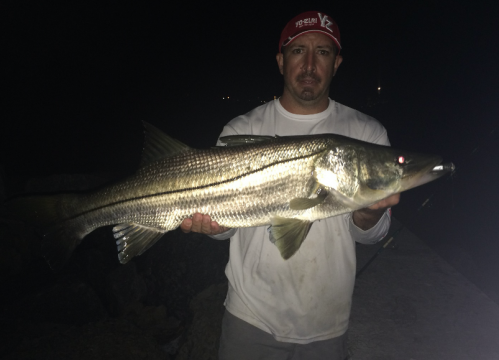
Recommended tackle for the Yo-Zuri 3D Inshore Fingerling is a 7 to 9ft rod in the 15-30lb class, with 30 or 40lb Yo-Zuri SuperBraid and 40lb TopKnot fluorocarbon leader. This tackle is light enough to throw a four-inch plug but still allows you enough strength to pull fish away from structure. One tip I would give is trying white braid for night fishing. The white braid allows you better visibility on the angle of your line and since it’s the raw form of braid it never fades. I choose TopKnot Fluorocarbon for the Fingerling because it has a very thin diameter which allows the plug to have a better swimming action while still giving you the strength and abrasion resistance to land fish in tight spaces between rocks or pilings. My color selection for this bait and time of year tends to be as realistic as possible with top colors being Real Pilchard, Ayu, Peanut Bunker or on full moon nights Ghost Shad. I like a green or olive bait with light sides because it mirrors the color patterns of Sardines and Pilchards, two of the main prey species in early September.
The second phase of the fall snook season is the start of the mullet run. This yearly occurrence is truly a National Geographic level event that has to be seen with your own eyes to appreciate. The mullet schools can be found during the day but its at night when the real fireworks go off. The key with fishing the mullet run is finding areas where the Snook stage and wait on the waves of schools of mullet to come through. Snook will feed on mullet in open water but without structure to isolate your lure it becomes an extremely frustrating needle in a haystack scenario. Two of the most common areas for Snook to stage during the run are again shadow lines at bridges and the rock jetties at inlets. Figuring where the large concentrations are going to be at each stage of the tide is key for putting yourself in the best possible position to capitalize on your opportunities. Where and when can differ from bridge to bridge and jetty to jetty and you simply have to put your time in to figure out the pattern.
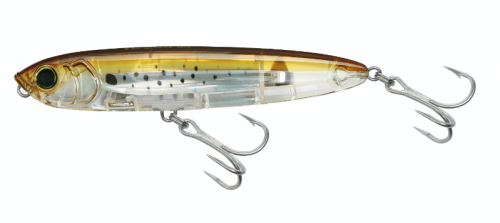
A couple of my favorite baits for fishing the mullet run at night are a pencil bait, either the 3D Inshore TopKnock Pencil 130 or the Hydro Pencil, and the Mag Darter. If I can get them to feed on it the topwater is my first choice because it’s the most enjoyable. The sound, feel and visual of a big Snook blowing up a topwater on a shadow line still gives me goosebumps just thinking about it, despite seeing it thousands of times over the last 30 years. The time when pencil baits are most effective is during the mullet run when Snook are popping mullet on the up current shadow line of the bridge. There are two main presentations that I have learned over the years. The first is a casting at a 45 degree angle into the light and having a slow and steady retrieve, no walking, as the current swings the bait into the shadow line. The plug will make a V in the water that looks very similar to the V that a mullet makes swimming along the surface. The other technique is to cast out into the light at a 45 angle or even straight out into the light and reeling very fast until the bait nears the shadow line, at which time you dead stick it. The plug will skip across the surface right up to the shadow line and then pause and float with the current into the shadow. This mirrors the action of mullet, which move very quickly in the light and tend to freeze when they hit a shadow line. The key with both techniques is to make sure the bait hits the shadow line right on the nose of the fish you’re targeting. Snook don’t want to move more than a couple inches to eat baits during the run because they don’t need to with millions of mullet pouring through the bridge.
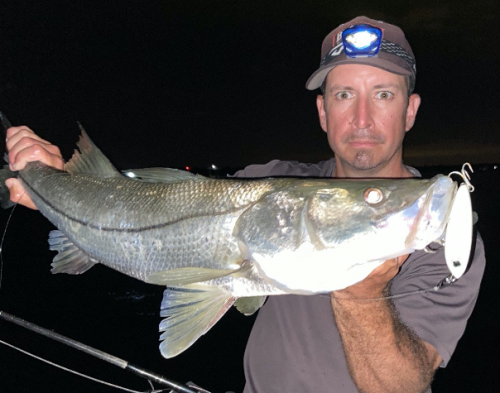
An under-utilized technique is fishing pencil baits at the jetty at night. It can be extremely frustrating fishing a swimming plug through millions of mullet on the beach side of jetties and watching explosion after explosion without a bite. When Snook are popping mullet on top you can make long casts over the school of bait and real in the plug with a slow and straight retrieve. Your plug will often part the school of mullet, isolating your bait and resulting in grenade like explosions. When using this technique make sure to real the plug all way back to the rock you are standing on as many of Snook wait for mullet to pin against the rocks making them easier to catch. Whether you’re fishing the bridge or the jetty with a pencil bait one of the most important things to remember is don’t react to the visual of the bite. Reel through the bite and let the rod start to load up with the weight of the fish before setting the hook. This is extremely important when fishing from an elevated position and will increase your hook up ratio and limit the number of times the plug comes flying back at your head (or the person next to you).
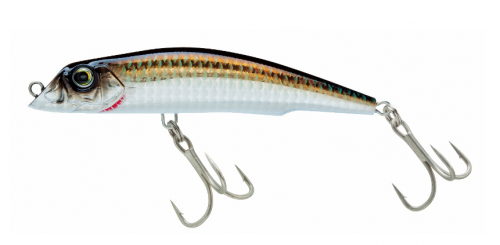
There are certain times during the mullet run when a swimming plug can be more effective than topwater. Its at these times that I turn to the Mag Darter. Darters are a northeast style bait used for targeting Striped Bass in the surf, back bays or on rips. There is no lip, instead the slanted head acts as the lip and gives the bait its action. Some darters are designed to dart side to side only with very little swimming action. That action works in certain situations for Striped Bass up north and Tarpon in Florida but is less effective on Snook. The Yo-Zuri Mag Darter is a swimming style darter that has a moderately wide swimming action and every few feet darts a few inches to one side or another. The action is extremely close to that of a scared mullet at night. The key for fishing this bait is fishing it cross current or against the current, when fished with the current it has very little action. One of my favorite places to throw this bait is from the side of the bridge on the up current side. You can stand on the seawall on the side of the bridge or anchor your boat outside the shadow line and cast out into light. A slow to moderate steady retrieve while letting the current swing your bait up against or just into (not more than 6 inches) the shadow line is most effective. You can adjust your retrieve speed and the angle of your position to make the bait travel in the perfect zone, 6 inches inside or outside the shadow line, down a large area of the bridge. That allows you to present the bait to large number of Snook and increases your chances of a bite. The Mag Darter is also effective when anchored or standing outside the shadow line and casting back into the dark and slow retrieving it out towards the shadow line. When fishing that technique, you can pause it in that key strike zone and let the current give the bait action, keeping your bait in the strike zone longer.
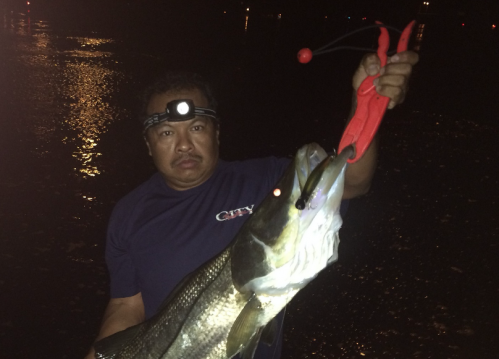
The Mag Darter is also very effective at the jetty. The main technique at most jetties is throwing it extremely close along the edge of the rocks and working it back slowly against the current. The darter doesn’t have a plastic lip to break so you can bounce it off the edges of the rocks without damaging it and get reaction bites that other baits don’t get. The patented magnetic weight transfer system in the Yo-Zuri darter gives you ability to make very long and extremely accurate casts. This is especially key fishing the jetty during the mullet run because the timing often coincides with Tropical Storms, Hurricanes and large northeast swells. The Mag Darter is very effective in crashing waves and white wash at the jetty where Snook feed on disoriented baitfish. In those conditions it stays in the water better than typical lipped plugs.
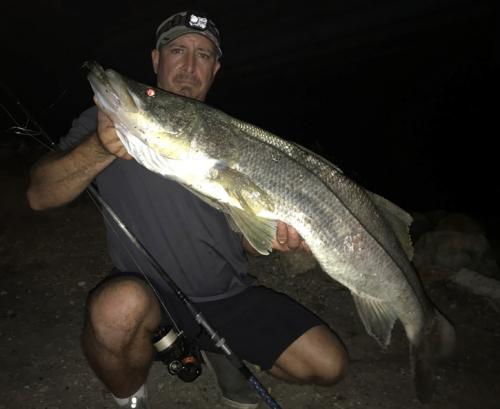
Tackle for fishing the Mag Darter, 3D Inshore TopKnock Pencil or Hydro Pencil in the mullet run is an 8 or 9ft rod with 40lb SuperBraid and 60lb HD Fluorocarbon leader. You need the heavier leader because 40+ inch fish are a real possibility and although the plug gives you some protection, they will choke it sometimes and the 60lb helps you from getting frayed off. The color selection for topwaters for the mullet run is very simple for me, either Bronze (Peanut Bunker) or Bone. I use either the bronze Hydro Pencil or the Peanut Bunker TopKnock 90% of the time. Bone is what I use on full moon or near full moon nights. The silhouette of the Bone pencil works well with a bright moon but on darker nights the nature bronze patterns are most effective. The pencil baits from Yo-Zuri come with 3X strength treble hooks that don’t need to be switched out and very importantly have only a single one knock cadence rattle, which is much more effective on Snook than baits with multiple loud BB rattles. My color patterns for the Mag Darter are very natural, either Bronze or Bronze Shiner.
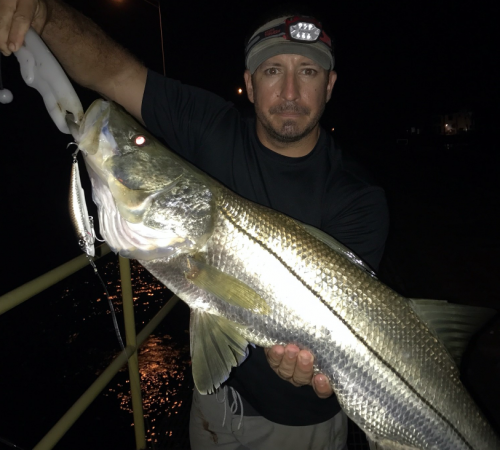
The third phase of the fall snook season is marked by the arrival of strong cold fronts and the end of the mullet run. There are still opportunities for catching fish on topwaters and swimming plugs when you find the right conditions but this is the time of the year when flair hawks and paddle tail swimbaits become most effective. The water temps start to drop and fish begin moving to deeper holes at the bridges or out onto the ledges at the inlets. The key for this time of the season is keeping your bait as close to the bottom as possible, low and slow is the name of the game.
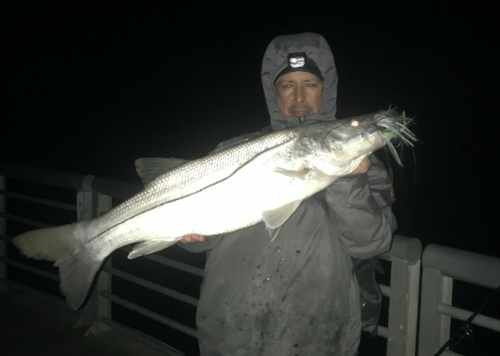
You can find quality flair hawk jigs at any local tackle shop from Miami to Melbourne on the east coast and up through Tampa on the west coast. They are a nylon jig with a longer bottom “tail” that comes in a variety of colors and sizes. For most applications the 1.5 oz size is best but in deeper water or heavier current a 2oz or even 3oz may be needed. In light current situations I tend to “swim” the jig cross current with a slow steady retrieve. In high current situations I tend to bounce the jig on the bottom cross current to ensure I stay in the strike zone and don’t get the jig up too high. My favorite colors for Snook are white body/green tail, white body/black tail, white body/blue tail or chartreuse body/blue tail. I tend to use white in cleaner water conditions and chartreuse on darker nights and darker water. Color isn’t as important as making sure you’re putting the jig in front of the fish on a consistent and repeated basis. At some jetties you can plan on losing a lot of jigs so be prepared to retie a lot, its just part of jig fishing. Paddle tail swim baits on 1.5-3oz jig heads can also be extremely effective this time of year. These are fished is similar locations, along the bottom at the bridge or jetty, and with similar techniques. There are several companies, local and national, making quality versions of this style bait. Color selection varies from person to person on their favorite and I have caught fish on everything from white, to lime green and orange or even dark purple. Jigs and swimbaits are pretty much all I throw after the mullet run ends but I also throw them from time to time during or even before the mullet run. One of my favorite times to throw them is during the mullet run under big silver mullet or black mullet schools. When the mullet are 8-15 inches or more a keeper Snook can eat them but they have to work for it. They tend to sit under the bait school and come up to ambush their prey rather than sitting on top on the shadow line like they do in finger mullet or smaller silver mullet (6-8inch) schools. During these conditions a jig or swimbait swam along the bottom into their face can be very effective and catch some of the biggest fish of the year.
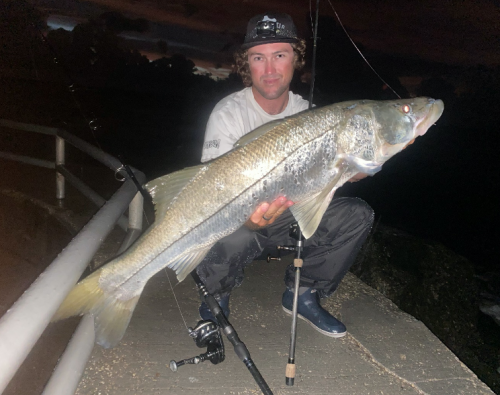
For jig or swimbait fishing I throw a 9ft rod, again with 40lb white Yo-Zuri SuperBraid and 80lb Yo-Zuri TopKnot or HD Fluorocarbon. Snook choke the jig or swimbait a lot and many times you’re trying to bring them up over a ledge so the heavy fluorocarbon leader is very important. Also, these baits tend to get a lot of 40+ inch fish in heavy current. Long casts are key, especially at the jetty so I don’t like to go above 40lb braid because you begin to lose casting distance.
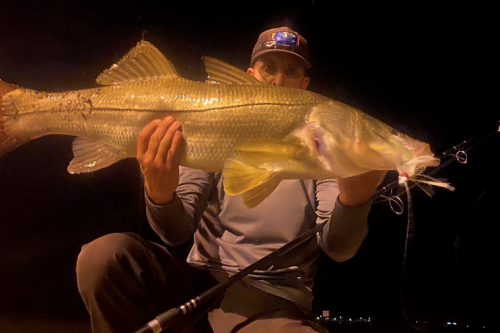
Hope this article helps you have a more successful fall Snook season this year. See you out there!
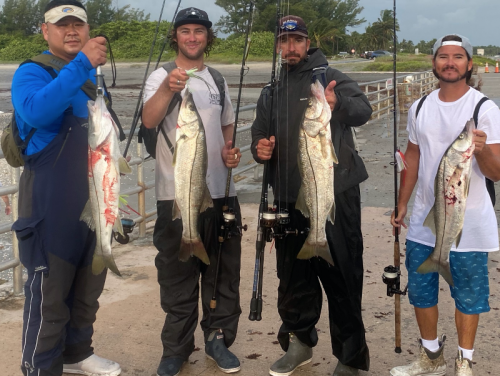
Christopher Bishop (Junochris)
HARDCORE Crankbaits: How-To with Dustin Wilks
I’m a shallow water, visual angler at heart, but often the most and biggest fish are offshore, particularly in Summer. One tip I can give you for offshore fishing is to start is locate of creek and river channels and concentrate on areas of bends or intersections. Electronics are good these days and many spots are easy to find on GPS and a quick idle will let you know if fish are there. If you are new to the game, you don’t have to be in the middle of the lake either, many times the best spots are on the upper ends of lakes and creeks that have the most current.
Since Hardcore has introduced their extensive crankbait series (Crank 60 MR and Crank 2+, 3+ and 4+, and New Bullet Crank), I’ve really found off-shore fishing much easier and enjoyable. Each bait has a patented weight transfer system making them cast much farther and easier with no tumbling or spinning. Casting distance is crucial to deep cranking too, allowing the bait to achieve maximum depth longer, and cover more water. Often when off shore bass are feeding, it is actually done up on the flats adjacent to the actual drop of, so these long casts are so important to locate feeding fish.
The feel and pull of these cranks is not like pulling in a bucket as many older designs. They have thinner, narrower bills and a slimmer profile helping them to be easy lures to crank, even to deeper water. The finishes are unbelievably tough and check every box on the colors I need. I’ve got a couple of MR 60’s that I’ve caught over a hundred fish each on and the paint barely shows it.
I’ll quickly go through each bait with when and where I try them. Knowing a whole line of baits has really helped my cranking, I know exactly what bait to reach for for any set of conditions. When you are out fishing crank baits in the summer bottom contact is what triggers bites, so you want that bait to be hitting the bottom the vast majority of the time, keep that in mind as I discuss below to apply to your fishing.
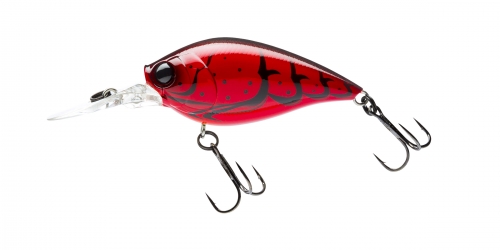
MR Crank 60
This is a little workhorse. It dives about 6-7 feet on 14lb Fluorocarbon, a little deeper on lighter line. This is the smallest bodied bait in the line and I use it year round on shallow areas of creek channel ledges. It has become an overall confidence bait for me even just going down the bank. I’ve gotten into several schools of fish while fishing with other people using different baits, and all my buddies now have tackle boxes full of these baits if that says anything. Don’t look for anyone to mention this bait, because once discovered, fishermen have a tendency to stay quiet. It comes through cover good, but most importantly this little thing casts a mile. With any smaller lures, casting becomes an issue, but not with this one.
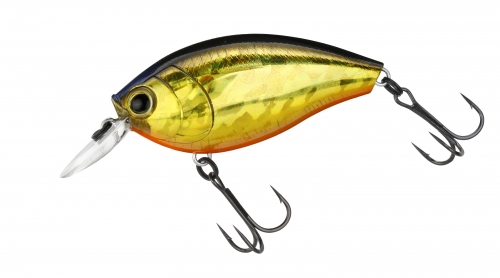
Crank 2+
Irreplaceable is the one word that comes to mind on this one. The 2+ means 2 meters and deeper, so about 6.5 feet. I find it is perfect if you want a bigger bodied bait with a nice body roll to hit water between 2 and 6 feet deep. This one fishes to me like an old balsa round wooden plug, except everyone of these runs perfect, casts like a bullet, and hits a deeper range. The bigger profile of this is really good if you are in a lake know for bigger fish or simple want to catch more bigger than average size fish. I use this bait in the same areas that I do the Crank 60, but when I want a bigger profile or the water is slightly shallower I often have both tied on, this one does a bit better in shallower water of 2-3 feet, but reaches 6.
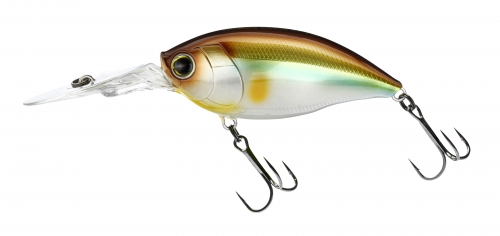
Crank 3+
8 feet. What is so special about 8 feet? It is actually a hard to find a crankbait that fishes that zone well without going into really deep divers. This bait is designed to hit 10-11, but on 14lb Yo-Zuri T-7 fluorocarbon around stump filled channels it is hitting 9, making it tick the bottom just perfect in this range. The special thing about it — it’s really easy to crank, so it is fun to fish. The action is somewhat tight and fast which is great for burning by inactive fish getting action bites. Once you feel this bait on your rod, you will be addicted like me and find it much easier to cover this depth range fast. With this bait I’m typically sitting in 12-15 feet of water to a ledge or flat spot 7-9 feet.
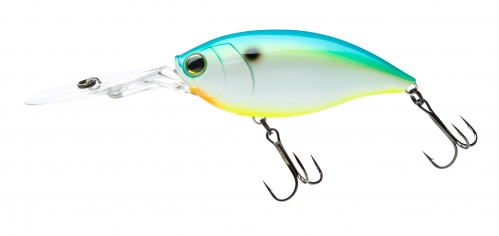
Crank 4+
12 feet of easy cranking. Burning this bait around all kinds of structure around 10 to 11 feet is a killer. This is bait is much the same as the 3+ buts gets an extra 3 feet deep, on a standard cast. The body size on this bait is smaller and slimmer than most crank baits in this category, catching fish of all sizes quickly. We all know that deep crank baits tend to get pretty big, but this one fills a nice size void and catches big ones too. I’ve caught bass up to 9 lbs on this bait. I’ve had crazy days with this plug catching them schooled up on structure even catching them two fish on the same bait at the same time on multiple times to top that off. If you reduce line size to 10 or 12 and long line this bait, it will hit depths of 20 feet plus. Long lining is a special technique that allows you bait to reach much deeper depths than intended on a standard casts.
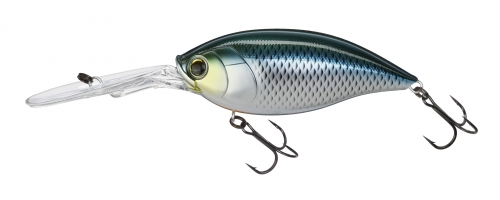
Bullet Crank
This is the grandaddy. This thing will hit 22 to 25 on a standard cast. Unlike the others in the series, this one will pull and requires a big long rod and high line capacity reel to fish it correctly. If you want big fish in that depth range on a standard cast this is your specialized bait. Have a bunch of these ready if you fish Tennessee river impoundments and lakes like Douglas in Tennessee and many others all over the country that are known for big fish that live really deep. I actually like this bait in the winter as well. When we first got prototypes it was the deal for deep cold water bass cranked slowly under bait. Typically this bait is for the summer though, you want to fish it really fast to trigger schools of fish. This is a bait you will want to know the fish are there before you cast, since it will give you a workout.
